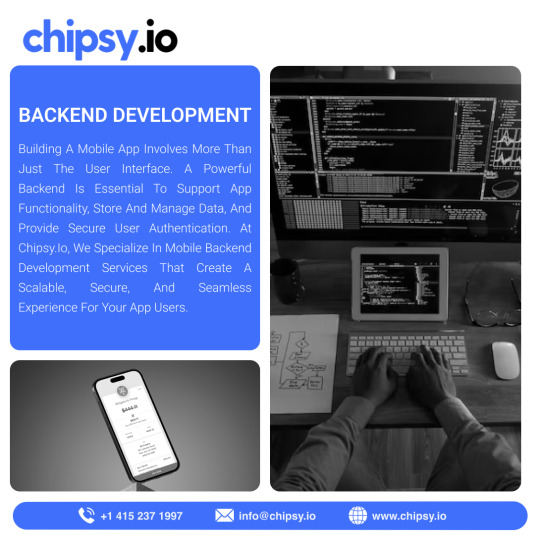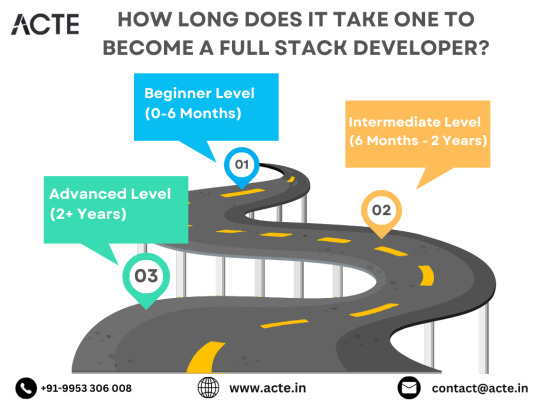#cloud backend development
Explore tagged Tumblr posts
Text

Summer Internship Program 2024
For More Details Visit Our Website - internship.learnandbuild.in
#machine learning#programming#python#linux#data science#data scientist#frontend web development#backend web development#salesforce admin#salesforce development#cloud AI with AWS#Internet of things & AI#Cyber security#Mobile App Development using flutter#data structures & algorithms#java core#python programming#summer internship program#summer internship program 2024
2 notes
·
View notes
Text
#python backend developer#android app developer in delhi#saas development companies india#saas application development services india#front end development india#front end developer companies#cloud application modernization#cloud migration india
0 notes
Text
Explore These Exciting DSU Micro Project Ideas
Explore These Exciting DSU Micro Project Ideas Are you a student looking for an interesting micro project to work on? Developing small, self-contained projects is a great way to build your skills and showcase your abilities. At the Distributed Systems University (DSU), we offer a wide range of micro project topics that cover a variety of domains. In this blog post, we’ll explore some exciting DSU…
#3D modeling#agricultural domain knowledge#Android#API design#AR frameworks (ARKit#ARCore)#backend development#best micro project topics#BLOCKCHAIN#Blockchain architecture#Blockchain development#cloud functions#cloud integration#Computer vision#Cryptocurrency protocols#CRYPTOGRAPHY#CSS#data analysis#Data Mining#Data preprocessing#data structure micro project topics#Data Visualization#database integration#decentralized applications (dApps)#decentralized identity protocols#DEEP LEARNING#dialogue management#Distributed systems architecture#distributed systems design#dsu in project management
0 notes
Text
Chipsy.io Backend Development: Unleashing the Power of Modern Technology
In the fast-evolving world of technology, businesses need robust, scalable, and secure backend systems to support their digital transformation. At Chipsy.io, we specialize in backend development, harnessing the power of cutting-edge technologies to build systems that drive your business forward.

Key Technologies
AWS: Leveraging Amazon Web Services (AWS), we provide scalable and flexible solutions that meet the demands of your business. From EC2 instances to Lambda functions, our expertise ensures your applications run smoothly and efficiently.
Azure: With Microsoft Azure, we deliver enterprise-grade solutions that integrate seamlessly with your existing infrastructure. Our services include everything from Azure App Services to Azure Functions, enabling rapid development and deployment.
Google Cloud Platform (GCP): Utilizing the power of GCP, we build highly scalable and resilient backend systems. Our capabilities include using Google Kubernetes Engine (GKE) for container orchestration and BigQuery for real-time analytics.
Best Practices
At Chipsy.io, we adhere to industry best practices to ensure the quality and reliability of our backend systems:
Microservices Architecture: We design our systems using a microservices architecture, allowing for independent development, deployment, and scaling of each service.
Continuous Integration/Continuous Deployment (CI/CD): Our CI/CD pipelines automate the testing and deployment process, ensuring rapid and reliable releases.
Security: We implement robust security measures, including data encryption, secure APIs, and regular security audits, to protect your sensitive information.
Monitoring and Logging: Our systems include comprehensive monitoring and logging solutions, providing real-time insights and facilitating quick issue resolution.
Future Trends
We stay ahead of the curve by continuously exploring emerging trends and technologies:
Serverless Computing: Our expertise in serverless architectures allows for building highly scalable applications without the need for server management.
Artificial Intelligence and Machine Learning: We integrate AI and ML capabilities into backend systems to provide advanced analytics and automation.
Edge Computing: By processing data closer to the source, we reduce latency and improve performance, especially for IoT applications.
Why Choose Chipsy.io?
Partnering with Chipsy.io for your backend development needs means gaining access to a team of experts dedicated to delivering high-quality, future-proof solutions. Our commitment to excellence and innovation ensures your business stays competitive in a digital-first world.
Ready to transform your backend systems? Contact Chipsy.io today and let us help you unleash the power of modern technology.
#backend development#aws#microsoft azure#mobile app design#artificial intelligence#machinelearning#google cloud platform#google cloud services
0 notes
Text
Introduction to Game Backend Development: Building the Foundation
In the dynamic and immersive world of gaming, the importance of a solid foundation cannot be overstated. Game backend development serves as this foundation, providing the infrastructure that supports critical functionalities and shapes the overall player experience. In this comprehensive exploration, we delve into the fundamentals of game backend development, understanding its role, key components, and the impact it has on creating successful games.
The Role of Backend Development in Gaming:
Game backend development refers to the creation and management of the server-side components that power a game. Unlike frontend development, which focuses on what players see and interact with directly, backend development handles the behind-the-scenes operations. This includes managing player accounts, handling real-time multiplayer interactions, facilitating in-game purchases, and much more.
Key Components of Game Backend Architecture:
User Authentication and Account Management:
The first step in establishing a secure gaming environment is implementing robust user authentication. This involves verifying the identity of players and ensuring secure access to their accounts.
Account management includes features like password recovery, account linking, and ensuring the privacy of user information.
Real-time Multiplayer Capabilities:
Enabling multiplayer functionality adds a social layer to games, allowing players to connect and compete with each other in real-time.
Backend development must address challenges such as synchronizing game states, minimizing latency, and ensuring a smooth multiplayer experience.
In-Game Purchases and Monetization Strategies:
Monetization is a crucial aspect of many games, and backend services play a pivotal role in facilitating in-game purchases.
Backend systems manage transactions securely, track virtual currency, and handle the complexities of various monetization models.
Leaderboards, Achievements, and Progress Tracking:
Creating a competitive and engaging environment involves implementing leaderboards that showcase player achievements and progress.
Backend services are responsible for accurately tracking and updating player stats, achievements, and leaderboard positions.
Why a Robust Backend Matters:
Scalability:
As a game gains popularity, the demand on backend services increases. A scalable backend ensures that the infrastructure can handle a growing user base without sacrificing performance.
Player Data Management:
Backend systems securely store and manage player data, including progress, achievements, and in-game purchases. This ensures a seamless experience for players across devices.
Enhanced Player Interaction:
Real-time multiplayer capabilities and social features foster a sense of community among players, contributing to higher retention rates and player satisfaction.
Monetization Opportunities:
A well-designed backend opens up avenues for monetization through in-game purchases, advertisements, and other revenue streams, contributing to the financial success of the game.
Conclusion:
In the ever-evolving gaming landscape, a robust backend is an unsung hero that enables seamless gameplay, fosters player interaction and unlocks monetization opportunities. Understanding the critical components of game backend development is essential for game developers aiming to create immersive and successful gaming experiences. As we proceed through this series, we will delve deeper into each component, exploring best practices, challenges, and innovations shaping the game backend development world.
For More Details and Services Please visit our website- Flentas Technologies
#Game Backend Development#Game Backend Development Services#game backend infrastructure#cloud gaming infrastructure
0 notes
Text
1 note
·
View note
Text
1. **Learn the basics of web development**: To create a PWA, you need to have a basic understanding of HTML, CSS, and JavaScript. These are the foundational languages for web development.
- HTML (Hypertext Markup Language) is used to create the structure of a website.
- CSS (Cascading Style Sheets) is used to style the website, such as colors, fonts, and layout.
- JavaScript is used to add interactivity and dynamic content to a website.
There are many online resources available for learning these languages. Some popular options include [Mozilla Developer Network (MDN) ↗](https://developer.mozilla.org/en-US/docs/Web), [FreeCodeCamp ↗](https://www.freecodecamp.org/), and [W3Schools ↗](https://www.w3schools.com/).
2. **Set up a Firebase project**: Firebase is a platform offered by Google that provides various tools and services to help you build web and mobile applications. You'll need to create a new Firebase project to use Firebase Hosting, Realtime Database, Authentication, and Messaging.
- Visit the [Firebase Console ↗](https://console.firebase.google.com/) and sign in with your Google account.
- Click on "Add project" and follow the prompts to create a new project.
3. **Learn about Firebase Hosting**: Firebase Hosting is a service that allows you to host your web app on a secure and fast server provided by Google. You'll need to set up Firebase Hosting for your project.
- Follow the [official Firebase Hosting documentation ↗](https://firebase.google.com/docs/hosting) to learn how to set up Firebase Hosting for your project. This will involve installing the Firebase CLI (Command Line Interface) tool, initializing your project, and deploying your web app.
4. **Learn about Firebase Realtime Database**: The Firebase Realtime Database is a cloud-hosted NoSQL database that lets you store and sync data across different devices in real-time.
- Follow the [official Firebase Realtime Database documentation ↗](https://firebase.google.com/docs/database) to learn how to set up and use the database in your project. This will involve connecting your web app to the database, writing data, reading data, and securing your data with rules.
5. **Learn about Firebase Authentication**: Firebase Authentication provides backend services to authenticate users in your app. It supports various authentication methods, such as email/password, social media logins, and more.
- Follow the [official Firebase Authentication documentation ↗](https://firebase.google.com/docs/auth) to learn how to set up and use authentication in your project. This will involve enabling authentication providers, creating user accounts, and managing user sessions.
6. **Learn about Firebase Cloud Messaging**: Firebase Cloud Messaging (FCM) is a messaging service that allows you to send notifications and messages to users of your app.
- Follow the [official Firebase Cloud Messaging documentation ↗](https://firebase.google.com/docs/cloud-messaging) to learn how to set up and use FCM in your project. This will involve configuring FCM, sending messages, and handling messages on the client side.
7. **Build your PWA**: Now that you have a basic understanding of web development and Firebase services, you can start building your PWA. Create public and private pages using HTML, CSS, and JavaScript while leveraging Firebase services to handle real-time data, user authentication, and messaging.
Remember that learning to code takes time and practice. Don't get discouraged if you encounter challenges along the way. The community around web development is vast, and you can find many resources to help you overcome any obstacles. Good luck!
#firebase#javascript#nosql#realtime database#chicago#app developers#database#google cloud#lemonbarski#personal website#webdevelopment#front end developers#backend#serverless#ai#ai generated#Poe ai
0 notes
Text
Another Internet Whitepaper
I'm just gonna get into there is no way to preface this.
1) content should be hosted in their own countries for which they are meant.
2) therefore the website should split into Nation->Sub-nation sections. So things for Michigan would be closer to those in Michigan. With U.S.->Michigan.
--"independent" Nations are just gonna have to deal with being lumped together into a united region. It's simply physics.
--country wide servers and clouds, and worldwide services will still be available; but we need to develop protocols to make it easier to distribute data and declutter the internet-cloud.
3) a separate Intranet for official use and security will need to be developed alongside this while also being completely disconnected from the worldwideweb.
4) Splits;
IP Addresses redesign;
[Country/Region]:[State/Province]:[individual]
[Individual] will need to be controlled by local The Internet Assigned Numbers Authority (IANA) branches; likely to be reassigned to DMVs and SoSs.
5) Separate protocols For;
Streaming Services
Social Media Services
Bidirectional Interactions (like games and Virtual Machines)
Pornography needs to be completely identifiable by textual Web address.
5) you local region will be defaulted, but can be changed by the browser and not be hard-wired in.
Not indicating a region will automatically default to the local internet.
So typing in FBI.GOV in the U.S. will lead to the FBI website, and if you type it in the UK it'll lead to Mi:5 or something.
6) Social Media protocols will have to be integrated with the E-Mail SMTP protocols. Which will encourage a more decentralized internet. This will *also* have to find a way to work with phone text messages.
7) Cable TV and Streaming services will have to use the same protocols.
8) Because there's phone integration here; a phone number may have to be closer to a social security number going forward. Which will both be bad for animosity, but allow for people to not need login information.
-- This will technically also need to apply to your House; which will have to have an assigned street address.
9) all of these need to be obfuscated to casual observers.
10) this will deprecate our phone companies and require them to work with cable TV and internet companies in order to create more equitable protocols.
11) the current IP address and Domain Registry systems need to be deprecated; as it does not suit its original purpose.
[.xxx] will be assigned for all "adult" materials and be required for ALL "adult materials" posted online.
[.app] will be assigned for appstores.
[.store] for marketplaces like Amazon, eBay, and whatever else.
[.bank] will be for banking and credit purposes
[.social] will be for social media
[.stream] will be for streaming materials,
[.np] for non-profit use only.
[.donation] for donation collections and Kickstarter like services.
[.pay] for payment services like PayPal
Non "adult materials" can be streamed through other "front ends" .
13) These human readable extensions will be simplified on the backend to reduce the total data envelope size.
14) single digit ip-adresses will have to be regulated for use for high-capacity uses. These will need to be "extended" protocols that different services can use.
This will help even out everybody's data envelopes. This will have to be part of a cloud service that can be used by anybody that needs it. With certain restrictions that are deemed necessary by local and federal governments and international treaty reasons.
15) limits on how algorithms and "bots" can ping anything at one time need to be addressed or regulated.
This will be a massive undertaking with the cooperation of all the other governments around the world.
And will be a very lucrative endeavor at the end of it all.
This is just an outline to describe the form the future internet should take and can be changed or modified as required; especially for things I cannot see.
The current corporations will be expected to develop a plan of actions in tandem with current regulatory authorities; failure to do so will create a need for an ultimatum, which we all wish to avoid.
We're also going to need to find ways to encourage competition in these sectors so that they can be upgraded and modified as needed by local areas instead of waiting on these companies to bother with it.
13 notes
·
View notes
Text
Why Python Will Thrive: Future Trends and Applications
Python has already made a significant impact in the tech world, and its trajectory for the future is even more promising. From its simplicity and versatility to its widespread use in cutting-edge technologies, Python is expected to continue thriving in the coming years. Considering the kind support of Python Course in Chennai Whatever your level of experience or reason for switching from another programming language, learning Python gets much more fun.

Let's explore why Python will remain at the forefront of software development and what trends and applications will contribute to its ongoing dominance.
1. Artificial Intelligence and Machine Learning
Python is already the go-to language for AI and machine learning, and its role in these fields is set to expand further. With powerful libraries such as TensorFlow, PyTorch, and Scikit-learn, Python simplifies the development of machine learning models and artificial intelligence applications. As more industries integrate AI for automation, personalization, and predictive analytics, Python will remain a core language for developing intelligent systems.
2. Data Science and Big Data
Data science is one of the most significant areas where Python has excelled. Libraries like Pandas, NumPy, and Matplotlib make data manipulation and visualization simple and efficient. As companies and organizations continue to generate and analyze vast amounts of data, Python’s ability to process, clean, and visualize big data will only become more critical. Additionally, Python’s compatibility with big data platforms like Hadoop and Apache Spark ensures that it will remain a major player in data-driven decision-making.
3. Web Development
Python’s role in web development is growing thanks to frameworks like Django and Flask, which provide robust, scalable, and secure solutions for building web applications. With the increasing demand for interactive websites and APIs, Python is well-positioned to continue serving as a top language for backend development. Its integration with cloud computing platforms will also fuel its growth in building modern web applications that scale efficiently.
4. Automation and Scripting
Automation is another area where Python excels. Developers use Python to automate tasks ranging from system administration to testing and deployment. With the rise of DevOps practices and the growing demand for workflow automation, Python’s role in streamlining repetitive processes will continue to grow. Businesses across industries will rely on Python to boost productivity, reduce errors, and optimize performance. With the aid of Best Online Training & Placement Programs, which offer comprehensive training and job placement support to anyone looking to develop their talents, it’s easier to learn this tool and advance your career.

5. Cybersecurity and Ethical Hacking
With cyber threats becoming increasingly sophisticated, cybersecurity is a critical concern for businesses worldwide. Python is widely used for penetration testing, vulnerability scanning, and threat detection due to its simplicity and effectiveness. Libraries like Scapy and PyCrypto make Python an excellent choice for ethical hacking and security professionals. As the need for robust cybersecurity measures increases, Python’s role in safeguarding digital assets will continue to thrive.
6. Internet of Things (IoT)
Python’s compatibility with microcontrollers and embedded systems makes it a strong contender in the growing field of IoT. Frameworks like MicroPython and CircuitPython enable developers to build IoT applications efficiently, whether for home automation, smart cities, or industrial systems. As the number of connected devices continues to rise, Python will remain a dominant language for creating scalable and reliable IoT solutions.
7. Cloud Computing and Serverless Architectures
The rise of cloud computing and serverless architectures has created new opportunities for Python. Cloud platforms like AWS, Google Cloud, and Microsoft Azure all support Python, allowing developers to build scalable and cost-efficient applications. With its flexibility and integration capabilities, Python is perfectly suited for developing cloud-based applications, serverless functions, and microservices.
8. Gaming and Virtual Reality
Python has long been used in game development, with libraries such as Pygame offering simple tools to create 2D games. However, as gaming and virtual reality (VR) technologies evolve, Python’s role in developing immersive experiences will grow. The language’s ease of use and integration with game engines will make it a popular choice for building gaming platforms, VR applications, and simulations.
9. Expanding Job Market
As Python’s applications continue to grow, so does the demand for Python developers. From startups to tech giants like Google, Facebook, and Amazon, companies across industries are seeking professionals who are proficient in Python. The increasing adoption of Python in various fields, including data science, AI, cybersecurity, and cloud computing, ensures a thriving job market for Python developers in the future.
10. Constant Evolution and Community Support
Python’s open-source nature means that it’s constantly evolving with new libraries, frameworks, and features. Its vibrant community of developers contributes to its growth and ensures that Python stays relevant to emerging trends and technologies. Whether it’s a new tool for AI or a breakthrough in web development, Python’s community is always working to improve the language and make it more efficient for developers.
Conclusion
Python’s future is bright, with its presence continuing to grow in AI, data science, automation, web development, and beyond. As industries become increasingly data-driven, automated, and connected, Python’s simplicity, versatility, and strong community support make it an ideal choice for developers. Whether you are a beginner looking to start your coding journey or a seasoned professional exploring new career opportunities, learning Python offers long-term benefits in a rapidly evolving tech landscape.
#python course#python training#python#technology#tech#python programming#python online training#python online course#python online classes#python certification
2 notes
·
View notes
Text

Learn and Build Summer Internship Program
For more details visit - Internship.learnandbuild.in
#data structures & algorithms#Java Core#Python Programming#Frontend web development#Backend web development#data science#machine learning & AI#Salesforce Admin#Salesforce Development#Cloud AI with AWS#Internet of things & AI#Cyber Security#Mobile app development using flutter
0 notes
Text
How Much Does React Native App Development Cost in California?

With the growing demand for mobile applications, businesses are increasingly opting for cross-platform solutions like React Native to reduce development time and costs. California, being a tech hub, has a vibrant ecosystem of app development companies, but the cost of development can vary significantly based on several factors. In this blog, we’ll explore the cost of React Native app development in California and what influences the pricing.
Factors Influencing React Native App Development Cost
1. Complexity of the App
The complexity of your app plays a crucial role in determining the cost. Apps can be categorized into three levels of complexity:
Simple Apps – Basic apps with minimal features, such as a calculator or to-do list. ($10,000 - $30,000)
Medium Complexity Apps – Apps with additional functionalities like user authentication, API integration, and database management. ($30,000 - $80,000)
Complex Apps – Feature-rich apps with real-time data sync, AI, AR/VR, or blockchain integration. ($80,000 - $200,000+)
2. UI/UX Design
An intuitive and appealing UI/UX is essential for user engagement. Custom designs and animations can increase costs but significantly improve user experience. UI/UX design costs in California typically range from $5,000 to $30,000depending on complexity.
3. Development Team
Hiring a development team in California is costlier than in many other regions due to high labor costs. The pricing varies based on the team’s experience:
Freelancers – $30 - $100 per hour
Small Agencies – $50 - $150 per hour
Established Development Firms – $100 - $250 per hour
4. Backend Development & Third-Party Integrations
If your app requires a strong backend, the cost increases. Cloud-based solutions like AWS, Firebase, or custom-built servers influence pricing. Additionally, integrating third-party services (payment gateways, APIs, analytics tools) can add $5,000 - $50,000 to the development cost.
5. Maintenance & Updates
Post-launch maintenance is essential for app stability. Maintenance costs can range from 15-20% of the total development cost per year to fix bugs, update features, and ensure compatibility with the latest OS versions.
Estimated Cost Breakdown for React Native App Development in California
Basic App Development - $10,000 - $30,000
Medium Complexity App - $30,000 - $80,000
Complex App Development - $80,000 - $200,000+
UI/UX Design$5,000 - $30,000
Backend & Integrations - $5,000 - $50,000
Maintenance (Annual) - 15-20% of dev cost
Ways to Reduce React Native App Development Cost
Prioritize MVP Development – Focus on a Minimum Viable Product (MVP) to validate the idea before investing heavily.
Outsource Development – Hiring offshore or nearshore teams can reduce costs while maintaining quality.
Utilize Pre-built Solutions – Use pre-existing UI components and third-party integrations to speed up development.
Choose a Cost-effective Development Partner – Partnering with an experienced yet cost-effective development firm ensures quality without overspending.
Final Thoughts
React Native app development costs in California can vary widely based on complexity, team expertise, and required features. While it’s a cost-effective alternative to native development, strategic planning is essential to optimize the budget. If you’re considering building a React Native app, consult a reputable development firm to get a tailored cost estimate based on your specific needs.
Need help with React Native app development? Contact us today for a free consultation!
#app development company in California#mobile app development company in California#app development company California#mobile app developer in California#app developer in California
2 notes
·
View notes
Text
What is SaaS and How to Build a SaaS Platform
What is SaaS? SaaS, or Software as a Service, is a cloud-based software delivery model where applications are hosted online and accessed through the internet. Unlike traditional software that requires installation, SaaS applications run on web browsers, offering convenience and flexibility. The provider manages all technical aspects, including updates, maintenance, and security, while users pay a subscription fee for access.
SaaS is popular for its cost-effectiveness and scalability. Businesses use SaaS for tools like customer relationship management (CRM) systems, project management platforms, and communication solutions. Consumers also rely on SaaS for entertainment and personal productivity.
How to Build a SaaS Platform If you're wondering how to build a SaaS platform, here are the essential steps:
Define Your Purpose: Start by identifying a problem that your SaaS platform will address. Research your audience and focus on a specific niche.
Plan Features: List features that add value, such as easy navigation, integrations, and real-time collaboration. Scalability should also be a priority.
Select the Right Technology: Choose technologies like React for frontend development, Node.js or Python for backend, and cloud hosting platforms like AWS.
Create an MVP: Build a Minimum Viable Product to test your concept, gather feedback, and refine your platform.
Ensure Security: Implement strong encryption, secure authentication, and regular updates to protect user data.
By understanding what SaaS is and following these steps, you can build a successful SaaS platform that meets market needs.
2 notes
·
View notes
Text
Complete Terraform IAC Development: Your Essential Guide to Infrastructure as Code
If you're ready to take control of your cloud infrastructure, it's time to dive into Complete Terraform IAC Development. With Terraform, you can simplify, automate, and scale infrastructure setups like never before. Whether you’re new to Infrastructure as Code (IAC) or looking to deepen your skills, mastering Terraform will open up a world of opportunities in cloud computing and DevOps.
Why Terraform for Infrastructure as Code?
Before we get into Complete Terraform IAC Development, let’s explore why Terraform is the go-to choice. HashiCorp’s Terraform has quickly become a top tool for managing cloud infrastructure because it’s open-source, supports multiple cloud providers (AWS, Google Cloud, Azure, and more), and uses a declarative language (HCL) that’s easy to learn.
Key Benefits of Learning Terraform
In today's fast-paced tech landscape, there’s a high demand for professionals who understand IAC and can deploy efficient, scalable cloud environments. Here’s how Terraform can benefit you and why the Complete Terraform IAC Development approach is invaluable:
Cross-Platform Compatibility: Terraform supports multiple cloud providers, which means you can use the same configuration files across different clouds.
Scalability and Efficiency: By using IAC, you automate infrastructure, reducing errors, saving time, and allowing for scalability.
Modular and Reusable Code: With Terraform, you can build modular templates, reusing code blocks for various projects or environments.
These features make Terraform an attractive skill for anyone working in DevOps, cloud engineering, or software development.
Getting Started with Complete Terraform IAC Development
The beauty of Complete Terraform IAC Development is that it caters to both beginners and intermediate users. Here’s a roadmap to kickstart your learning:
Set Up the Environment: Install Terraform and configure it for your cloud provider. This step is simple and provides a solid foundation.
Understand HCL (HashiCorp Configuration Language): Terraform’s configuration language is straightforward but powerful. Knowing the syntax is essential for writing effective scripts.
Define Infrastructure as Code: Begin by defining your infrastructure in simple blocks. You’ll learn to declare resources, manage providers, and understand how to structure your files.
Use Modules: Modules are pre-written configurations you can use to create reusable code blocks, making it easier to manage and scale complex infrastructures.
Apply Best Practices: Understanding how to structure your code for readability, reliability, and reusability will save you headaches as projects grow.
Core Components in Complete Terraform IAC Development
When working with Terraform, you’ll interact with several core components. Here’s a breakdown:
Providers: These are plugins that allow Terraform to manage infrastructure on your chosen cloud platform (AWS, Azure, etc.).
Resources: The building blocks of your infrastructure, resources represent things like instances, databases, and storage.
Variables and Outputs: Variables let you define dynamic values, and outputs allow you to retrieve data after deployment.
State Files: Terraform uses a state file to store information about your infrastructure. This file is essential for tracking changes and ensuring Terraform manages the infrastructure accurately.
Mastering these components will solidify your Terraform foundation, giving you the confidence to build and scale projects efficiently.
Best Practices for Complete Terraform IAC Development
In the world of Infrastructure as Code, following best practices is essential. Here are some tips to keep in mind:
Organize Code with Modules: Organizing code with modules promotes reusability and makes complex structures easier to manage.
Use a Remote Backend: Storing your Terraform state in a remote backend, like Amazon S3 or Azure Storage, ensures that your team can access the latest state.
Implement Version Control: Version control systems like Git are vital. They help you track changes, avoid conflicts, and ensure smooth rollbacks.
Plan Before Applying: Terraform’s “plan” command helps you preview changes before deploying, reducing the chances of accidental alterations.
By following these practices, you’re ensuring your IAC deployments are both robust and scalable.
Real-World Applications of Terraform IAC
Imagine you’re managing a complex multi-cloud environment. Using Complete Terraform IAC Development, you could easily deploy similar infrastructures across AWS, Azure, and Google Cloud, all with a few lines of code.
Use Case 1: Multi-Region Deployments
Suppose you need a web application deployed across multiple regions. Using Terraform, you can create templates that deploy the application consistently across different regions, ensuring high availability and redundancy.
Use Case 2: Scaling Web Applications
Let’s say your company’s website traffic spikes during a promotion. Terraform allows you to define scaling policies that automatically adjust server capacities, ensuring that your site remains responsive.
Advanced Topics in Complete Terraform IAC Development
Once you’re comfortable with the basics, Complete Terraform IAC Development offers advanced techniques to enhance your skillset:
Terraform Workspaces: Workspaces allow you to manage multiple environments (e.g., development, testing, production) within a single configuration.
Dynamic Blocks and Conditionals: Use dynamic blocks and conditionals to make your code more adaptable, allowing you to define configurations that change based on the environment or input variables.
Integration with CI/CD Pipelines: Integrate Terraform with CI/CD tools like Jenkins or GitLab CI to automate deployments. This approach ensures consistent infrastructure management as your application evolves.
Tools and Resources to Support Your Terraform Journey
Here are some popular tools to streamline your learning:
Terraform CLI: The primary tool for creating and managing your infrastructure.
Terragrunt: An additional layer for working with Terraform, Terragrunt simplifies managing complex Terraform environments.
HashiCorp Cloud: Terraform Cloud offers a managed solution for executing and collaborating on Terraform workflows.
There are countless resources available online, from Terraform documentation to forums, blogs, and courses. HashiCorp offers a free resource hub, and platforms like Udemy provide comprehensive courses to guide you through Complete Terraform IAC Development.
Start Your Journey with Complete Terraform IAC Development
If you’re aiming to build a career in cloud infrastructure or simply want to enhance your DevOps toolkit, Complete Terraform IAC Development is a skill worth mastering. From managing complex multi-cloud infrastructures to automating repetitive tasks, Terraform provides a powerful framework to achieve your goals.
Start with the basics, gradually explore advanced features, and remember: practice is key. The world of cloud computing is evolving rapidly, and those who know how to leverage Infrastructure as Code will always have an edge. With Terraform, you’re not just coding infrastructure; you’re building a foundation for the future. So, take the first step into Complete Terraform IAC Development—it’s your path to becoming a versatile, skilled cloud professional
2 notes
·
View notes
Text
The Roadmap to Full Stack Developer Proficiency: A Comprehensive Guide
Embarking on the journey to becoming a full stack developer is an exhilarating endeavor filled with growth and challenges. Whether you're taking your first steps or seeking to elevate your skills, understanding the path ahead is crucial. In this detailed roadmap, we'll outline the stages of mastering full stack development, exploring essential milestones, competencies, and strategies to guide you through this enriching career journey.

Beginning the Journey: Novice Phase (0-6 Months)
As a novice, you're entering the realm of programming with a fresh perspective and eagerness to learn. This initial phase sets the groundwork for your progression as a full stack developer.
Grasping Programming Fundamentals:
Your journey commences with grasping the foundational elements of programming languages like HTML, CSS, and JavaScript. These are the cornerstone of web development and are essential for crafting dynamic and interactive web applications.
Familiarizing with Basic Data Structures and Algorithms:
To develop proficiency in programming, understanding fundamental data structures such as arrays, objects, and linked lists, along with algorithms like sorting and searching, is imperative. These concepts form the backbone of problem-solving in software development.
Exploring Essential Web Development Concepts:
During this phase, you'll delve into crucial web development concepts like client-server architecture, HTTP protocol, and the Document Object Model (DOM). Acquiring insights into the underlying mechanisms of web applications lays a strong foundation for tackling more intricate projects.
Advancing Forward: Intermediate Stage (6 Months - 2 Years)
As you progress beyond the basics, you'll transition into the intermediate stage, where you'll deepen your understanding and skills across various facets of full stack development.

Venturing into Backend Development:
In the intermediate stage, you'll venture into backend development, honing your proficiency in server-side languages like Node.js, Python, or Java. Here, you'll learn to construct robust server-side applications, manage data storage and retrieval, and implement authentication and authorization mechanisms.
Mastering Database Management:
A pivotal aspect of backend development is comprehending databases. You'll delve into relational databases like MySQL and PostgreSQL, as well as NoSQL databases like MongoDB. Proficiency in database management systems and design principles enables the creation of scalable and efficient applications.
Exploring Frontend Frameworks and Libraries:
In addition to backend development, you'll deepen your expertise in frontend technologies. You'll explore prominent frameworks and libraries such as React, Angular, or Vue.js, streamlining the creation of interactive and responsive user interfaces.
Learning Version Control with Git:
Version control is indispensable for collaborative software development. During this phase, you'll familiarize yourself with Git, a distributed version control system, to manage your codebase, track changes, and collaborate effectively with fellow developers.
Achieving Mastery: Advanced Phase (2+ Years)
As you ascend in your journey, you'll enter the advanced phase of full stack development, where you'll refine your skills, tackle intricate challenges, and delve into specialized domains of interest.
Designing Scalable Systems:
In the advanced stage, focus shifts to designing scalable systems capable of managing substantial volumes of traffic and data. You'll explore design patterns, scalability methodologies, and cloud computing platforms like AWS, Azure, or Google Cloud.
Embracing DevOps Practices:
DevOps practices play a pivotal role in contemporary software development. You'll delve into continuous integration and continuous deployment (CI/CD) pipelines, infrastructure as code (IaC), and containerization technologies such as Docker and Kubernetes.
Specializing in Niche Areas:
With experience, you may opt to specialize in specific domains of full stack development, whether it's frontend or backend development, mobile app development, or DevOps. Specialization enables you to deepen your expertise and pursue career avenues aligned with your passions and strengths.
Conclusion:
Becoming a proficient full stack developer is a transformative journey that demands dedication, resilience, and perpetual learning. By following the roadmap outlined in this guide and maintaining a curious and adaptable mindset, you'll navigate the complexities and opportunities inherent in the realm of full stack development. Remember, mastery isn't merely about acquiring technical skills but also about fostering collaboration, embracing innovation, and contributing meaningfully to the ever-evolving landscape of technology.
#full stack developer#education#information#full stack web development#front end development#frameworks#web development#backend#full stack developer course#technology
9 notes
·
View notes
Text
Ludo Game Development Company

Ludo is a beloved board game that has easily moved into the online world. Its fun and exciting gameplay makes it perfect for mobile and online platforms, attracting players of all ages. Enixo Studio is a top game development company that specializes in creating engaging Ludo games, which have thrilled millions of players.
Successful Ludo Games by Enixo Studio
Enixo Studio has released several popular Ludo games, including Ludo Bazi, Ludo Pasa, Ludo Premium, Ludo Jungle, Ludo Crash, Ludo Pot, Ludo Prime, Ludo Grand, Ludo Pay, and Ludo Peso.
Key Features of Enixo’s Ludo Games
Enixo Studio focuses on providing a fantastic gaming experience. Here are some great features of their Ludo games:
Multiplayer Mode: Play with friends or other players from around the world. You can play with 2 to 4 players.
Chat Functionality: Talk to other players using the built-in chat. You can send emojis and stickers to make the game more fun.
User-Friendly Interface: The design is easy to understand for players of all ages, with simple menus and settings.
In-Game Purchases: Unlock new skins, themes, and power-ups. You can buy coins or gems to enhance your game.
Multiple Variations: Choose from different game modes like Classic, Quick Play, and Tournament, each with its own rules.
Engaging Graphics: Enjoy colorful and high-quality graphics that make the game enjoyable. There are fun animations for rolling dice and moving pieces.
Real-Time Leaderboards: Check your rankings globally and among friends. Daily and weekly leaderboards keep the competition alive.
Secure Payment Gateway: Safe and easy transactions for in-game purchases with different payment options.
Social Media Integration: Share your achievements and game invites on social media. You can log in easily using your Facebook or Google account.
Push Notifications: Stay informed about game events, challenges, and new features. Get reminders for friends to join or finish matches.
Customizable Avatars: Create and personalize your avatars with different clothing, accessories, and colors.
Offline Mode: Play against AI when you’re not online. It’s perfect for solo practice and fun.
Daily Rewards: Log in every day to earn bonuses, coins, and special items through daily challenges.
User Support: Get help within the app for any issues or questions. There are FAQs and guides to assist new players with the game rules.
Technologies Used in Ludo Game Development
Enixo Studio uses the latest technologies to ensure their Ludo games are robust, responsive, and enjoyable. Some of the technologies include:
Unity Engine: For amazing 2D and 3D graphics.
Socket.io: For real-time communication in multiplayer games.
MEAN Stack: For a strong and scalable backend.
React Native: For developing mobile apps that work on multiple platforms.
Firebase: For cloud storage and real-time database features.
Ludo Game Development Companies in India
Here’s a list of cities where you can find talented developers:
Ludo Game Development Companies in Delhi
Ludo Game Development Companies in Noida
Ludo Game Development Companies in Jaipur
Ludo Game Development Companies in Lucknow
Ludo Game Development Companies in Patna
Ludo Game Development Companies in Indore
Ludo Game Development Companies in Gurgaon
Ludo Game Development Companies in Surat
Ludo Game Development Companies in Bengaluru
Ludo Game Development Companies in Chennai
Ludo Game Development Companies in Ahmedabad
Ludo Game Development Companies in Hyderabad
Ludo Game Development Companies in Mumbai
Ludo Game Development Companies in Pune
Ludo Game Development Companies in Dehradun
Conclusion
Enixo Studio is an excellent choice for anyone looking to create exciting and popular Ludo games. With a proven track record of successful projects and a commitment to the latest technologies, they can turn your Ludo game ideas into reality.
If you want custom Ludo games, contact Enixo Studio at enixo.in, email us at [email protected], or WhatsApp us at +917703007703. You can also check our profiles on Behance or Dribbble to see our work. Whether you’re looking for a simple game or a complex multiplayer platform, Enixo Studio has the expertise to make it happen.
#ludo game development services#ludo source code#game development#ludo money#zupee#ludo supreme#ludo bazi#ludo app make#ludo cash#ludo game development company#best ludo app#gamedevelopment#game#game art#game design#gamedev#gamers of tumblr#game developers#games#ludo studio#ludo game development#ludo game developers
3 notes
·
View notes
Text
Best 10 Business Strategies for year 2024
In 2024 and beyond, businesses will have to change with the times and adjust their approach based on new and existing market realities. The following are the best 10 business approach that will help companies to prosper in coming year
1. Embrace Sustainability
The days when sustainability was discretionary are long gone. Businesses need to incorporate environmental, social and governance (ESG) values into their business practices. In the same vein, brands can improve brand identity and appeal to environmental advocates by using renewable forms of energy or minimizing their carbon footprints.
Example: a fashion brand can rethink the materials to use organic cotton and recycled for their clothing lines. They can also run a take-back scheme, allowing customers to return old clothes for recycling (not only reducing waste but creating and supporting the circular economy).
2. Leverage AI

AI is revolutionizing business operations. Using AI-fuelled solutions means that you can automate processes, bring in positive customer experiences, and get insights. AI chatbots: AI can be utilized in the form of a conversational entity to support and perform backend operations, as well.
With a bit more specificity, say for example that an AI-powered recommendation engine recommends products to customers based on their browsing history and purchase patterns (as the use case of retail). This helps to increase the sales and improve the shopping experience.
3. Prioritize Cybersecurity
Cybersecurity is of utmost important as more and more business transitions towards digital platforms. Businesses need to part with a more substantial amount of money on advanced protective measures so that they can keep sensitive data private and continue earning consumer trust. Regular security audits and training of employees can reduce these risks.
Example: A financial services firm may implement multi-factor authentication (MFA) for all online transactions, regularly control access to Internet-facing administrative interfaces and service ports as well as the encryption protocols to secure client data from cyberattacks.
4. Optimizing Remote and Hybrid Working Models

Remote / hybrid is the new normal Remote teams force companies to implement effective motivation and management strategies. Collaboration tools and a balanced virtual culture can improve productivity and employee satisfaction.
- Illustration: a Tech company using Asana / Trello etc. for pm to keep remote teams from falling out of balance. They can also organise weekly team-building activities to keep a strong team spirit.
5. Focus on Customer Experience
Retention and growth of the sales follow-through can be tied to high quality customer experiences. Harness data analytics to deepen customer insights and personalize product offers making your marketing campaigns personal: a customer support that is responsive enough can drive a great level of returning customers.
Example – For any e-commerce business, you can take user experience feedback tools to know about how your customers are getting along and make necessary changes. Custom email campaigns and loyalty programs can also be positively associated with customer satisfaction and retention.
6. Digitalization Investment

It is only the beginning of digital transformation which we all know, is key to global competitiveness. For streamlining, companies have to adopt the use advanced technologies such as Blockchain Technology and Internet of Things (IoT) in conjunction with cloud computing.
IoT example : real-time tracking and analytics to optimize supply chain management
7. Enhance Employee Skills
Develop Your Employees: Investing in employee development is key to succeeding as a business. The training is provided for the folks of various industries and so employees can increase their skills that are needed to work in a certain company. Employee performance can be enhanced by providing training programs in future technology skills and soft skills and job satisfaction.
Example: A marketing agency can host webinars or create courses to teach people the latest digital marketing trends and tools This can help to keep employees in the know which results in boosting their skills, making your campaigns successful.
8. Diversify Supply Chains

The ongoing pandemic has exposed the weaknesses of global supply chains. …diversify its supply base and promote the manufacturing of drugs in Nigeria to eliminate total dependence on a single source. In return, this approach increases resilience and reduces exposure to the risks of supply chain interruption.
- E.g., a consumer electronics company can source components from many suppliers in various regions. In so doing, this alleviates avoidable supply chain interruptions during times of political tensions or when disasters hit.
9. Make Decisions Based on Data
A business database is an asset for businesses. By implementing data, they allow you to make decisions based on the data that your analytics tools are providing. For example, sales analysis lets you track trends and better tailor your goods to the market.
Example: A retail chain can use data analytics to find out when a customer buys, and it change their purchasing policies. This can also reduce overstock and stockouts while overall, increasing efficiency.
10. Foster Innovation

Business Growth Innovation is Key A culture of creativity and experimentation should be established in companies. Funding R&D and teaming with startups can open many doors to both solve problems creatively but also tap into new markets.
Example: A software development firm could create an innovation lab where team members are freed to work on speculative projects. Moreover, work with start-ups on new technologies and solutions.
By adopting these strategies, businesses can navigate the turbulence for 2024 and roll up market — progressive.AI with an evolving dynamic market, being ahead of trends and updated is most likely will help you thrive in the business landscape.
#ai#business#business strategy#business growth#startup#fintech#technology#tech#innovation#ai in business
2 notes
·
View notes